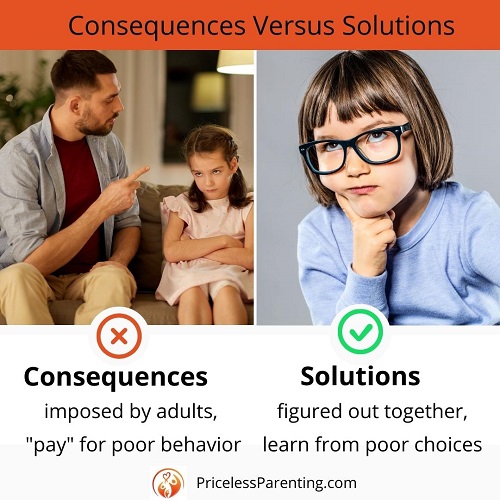Finding Solutions Versus Issuing Consequences
by Kathy Slattengren, M. Ed., Priceless Parenting (sign up for monthly parenting newsletter and receive 20+ printable charts for kids and parents)

When your kids misbehave, how do you usually feel? Most parents report feeling angry, frustrated or embarrassed. When you're feeling like that it's easy to think of consequences that will make your children pay for their poor behavior. They won't dare do that again!
When you use punishment in response to your children's misbehavior, they usually learn to avoid getting caught in the future. However, they aren't necessarily learning how to develop self-discipline and make better choices. By focusing on solutions instead of punishment, you increase the chances that it doesn't happen again - even if you're not around.
Watching a Fight Instead of Walking Away
On the way home from a Seattle middle school, two boys got into a fight near the school bus stop. There was some pushing and shoving involved and other kids were standing around watching. During this skirmish, one boy took a video of it on his phone. When he got home, he posted the video on YouTube.
After seeing the video, the school officials decided to punish all the kids in the video - those watching and those fighting - with a one day suspension. The school policy is that kids should walk away when a fight breaks out so that they don't add support to what is going on. The kids have been taught this during school assemblies.
This situation is rich with learning opportunities. The kids could have stayed after school for a practice session where they role played these types of situations and practiced what they should do. They also could have engaged in a serious dialog about what is and is not appropriate to be posting online.
None of this learning took place in any structured way because the kids were at home for a day instead of engaged in practicing better responses. By punishing the kids instead of looking for solutions, a golden opportunity was missed to help these kids grow from this experience.
Running Away When It's Time to Leave
One day Melina came to pick her daughter Avery up from preschool. Avery decided to hide under the table. Melina wasn't able to coax Avery to come out so she tried reaching under the table to grab Avery's arm. As she reached for Avery, Avery scooted to the other side just out of her mom's reach.
Avery was clearly having a good time playing this little keep-away game and mom was getting more upset by the minute. It was especially embarrassing with the audience of teachers and other parents. Finally one of the teachers helped her get Avery out from under the table.
After Melina got Avery into the car, she yelled at her for causing a scene. She told Avery there would be no dessert or treats the rest of the day. Avery was in tears and mom was still fuming.
How could Melina have worked towards a solution instead of just punishing Avery? She might have tried practicing the correct behavior with Avery at home in pretend situations. Perhaps she could change her pick up routine by immediately taking Avery's hand rather than first engaging with other parents in conversation. When you start thinking about solutions to a problem, a lot of possibilities open up.
Forgetting to Call When Staying Late After School
A mom explained how worried and angry she was when her son did not come home from school one day and failed to let her know where he was. Although he has a cellphone, he forgot to call and let her know he was staying after school to work on a project.
When he came home, she told him the consequence for his forgetting to call was that he would not be able to watch TV for a week. After suffering this consequence, hopefully he will remember to call next time.
How would this situation be different if instead of issuing a consequence, they looked for a solution? What solutions might work? Perhaps he could set an alarm on his cellphone for 5 minutes after school ends to remind him to call if he wasn't coming straight home. Or he could write his after school plans on a calendar at home. He could also leave a note on the kitchen table in the morning if he planned to stay late.
Finding Solutions to Problems
When you start considering solutions to problems, you'll find there are many possibilities. You can work with your child to generate a list of possible solutions. Let your child select the solution to try. If the problem occurs again, work with your child to tweak the solution or choose a different one.
If you want your kids to behave differently in the future, then you need to focus on solutions that teach and encourage that new behavior. When you focus on solutions, you send your kids the message that you believe they are capable of better behavior. You also show them that you are willing to help them achieve it.